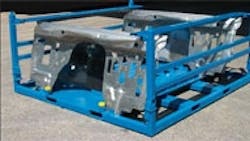When Freightliner LLC (Portland, Ore.), a heavy-duty truck manufacturer, prepared to launch its new class 8 model vehicle, Cascadia, a major focus was directed at optimizing the efficiency and quality of its supply chain. The new vehicle launch required many irregular sized and shaped components, so the company opted for custom packaging from SteelKing, Stevens Point, Wis., www.steelking.com).
“Once the parts are manufactured, they need to be delivered in the same condition,” says Royce Hermens, a packaging engineering group leader at Freightliner. “This is critical for logistics, quality control and cost containment since vehicles can’t be sold if they’re waiting for replacement parts due to part damage caused by shipping.”
As an original equipment manufacturer familiar with receiving less than truckload shipments, Freightliner was mindful of the increased wear that extra unloading and reloading packages receive. Extra handling is always required when consolidating product at transport terminals. In addition, with environmental concerns growing and some states prohibiting the disposal of wood pallets at landfills, the company wanted to limit its use of disposable packaging.
For a number of key components, Freightliner chose custom packaging offered by Steel King Industries, a manufacturer and provider of shipping racks, portable racks and portable racking. The shipping rack supplier helped Freightliner streamline logistics for the vehicle launch while enhancing quality control and cost containment.
The size, shape and aesthetics of a day-cab roof assembly, for instance, meant Freightliner would have shipped one per pallet if it used expendable packaging. Units could not be stacked because of a risk of denting, scratching and other damage. Instead, “They built us custom shipping racks that accommodate eight parts each and stack two-high in trailers,” says Hermens. “That’s a 16-to-1 increase in shipping storage density with better protection. We, and our suppliers, can stack five high in warehouses, which further improves storage density and makes it easier to store product indoors instead of out.”
Freightliner pays for returning the shipping racks sent to its parts suppliers. The benefit of having a front wall that knocks down, along with fold-down corners, means the racks cut return shipping costs by a third, says Hermens.
The shipping racks also contain protective padding only where needed. Consequently they do their part to improve quality control while eliminating the purchase and
disposal costs of expendable packaging. “The word from our warehouses and our suppliers is that product damage is not a problem with the custom shipping racks,” says Hermens.
ROI for the containers is expected in one year.
